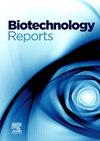Rhizobial, passenger nodule endophytes and phyllosphere bacteria in combination with acyl homoserine lactones enhances the growth and yield of groundnut
Q1 Immunology and Microbiology
引用次数: 0
Abstract
Quorum sensing (QS) mechanisms play an essential role in mediating several signals and plant-bacteria interactions, promoting plant growth. This study demonstrated production of multiple Homoserine lactone (HSL) molecules like C6 HSL, C7 HSL, C8 HSL, 3-Hydroxy-C8-HSL and 3-oxo-C14 HSL in rhizobial and passenger endophytes and phyllospheric bacteria which regulated production of plant growth promoting traits viz., indole acetic acid and exo-polysaccharide production, biofilm formation, and motility. Quorum quenching (QQ) molecules like salicylic acid, gallic acid, and disalicylic acid impaired these traits, but exogenous addition of QS molecules (C7HSL and 3-oxo-C14 HSL) restored these inhibitory effects of QQ compounds. The pot culture experiment revealed that the treatment involving Methylobacterium populi TMV7–4 or Enterobacter cloacae S23 with salicylic acid, C7HSL and 3-oxo-C14 HSL significantly enhanced plant growth including root length, nodulation, pod formation, soil available nutrients and plant nutrients uptake. In future field validation is required for the use of QS molecules in improving groundnut production.
根瘤菌、乘客根瘤内生菌和根瘤菌与酰基高丝氨酸内酯共同作用可促进花生的生长和产量
群体感应(Quorum sensing, QS)机制在介导多种信号和植物与细菌相互作用、促进植物生长等方面发挥着重要作用。本研究证实了根瘤菌、客源内生菌和层球细菌产生C6、C7、C8、3-羟基-C8-HSL和3-氧基- c14 HSL等多种高丝氨酸内酯(HSL)分子,调节植物生长促进性状的产生,如吲哚乙酸和外多糖的产生、生物膜的形成和运动。水杨酸、没食子酸和二水杨酸等群体猝灭(Quorum quenching, QQ)分子破坏了这些性状,但外源添加QS分子(C7HSL和3-oxo-C14 HSL)恢复了QQ化合物的抑制作用。盆栽试验结果表明,水杨酸、C7HSL和3-oxo-C14 HSL处理下,populi甲基杆菌TMV7-4或cloacae肠杆菌S23显著促进了植物的生长,包括根长、结瘤、结荚、土壤速效养分和植物养分吸收。在未来,需要对QS分子在提高花生产量方面的应用进行实地验证。
本文章由计算机程序翻译,如有差异,请以英文原文为准。
求助全文
约1分钟内获得全文
求助全文
来源期刊

Biotechnology Reports
Immunology and Microbiology-Applied Microbiology and Biotechnology
CiteScore
15.80
自引率
0.00%
发文量
79
审稿时长
55 days
期刊介绍:
Biotechnology Reports covers all aspects of Biotechnology particularly those reports that are useful and informative and that will be of value to other researchers in related fields. Biotechnology Reports loves ground breaking science, but will also accept good science that can be of use to the biotechnology community. The journal maintains a high quality peer review where submissions are considered on the basis of scientific validity and technical quality. Acceptable paper types are research articles (short or full communications), methods, mini-reviews, and commentaries in the following areas: Healthcare and pharmaceutical biotechnology Agricultural and food biotechnology Environmental biotechnology Molecular biology, cell and tissue engineering and synthetic biology Industrial biotechnology, biofuels and bioenergy Nanobiotechnology Bioinformatics & systems biology New processes and products in biotechnology, bioprocess engineering.
 求助内容:
求助内容: 应助结果提醒方式:
应助结果提醒方式:


